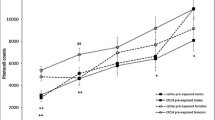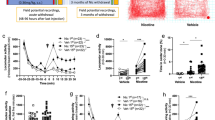Abstract
Rationale
Adolescent smoking is an increasing epidemic in the US. Research has shown that the commencement of smoking at a young age increases addiction and decreases the probability of successful cessation; however, limited work has focused on nicotine dependence in the female.
Objective
The goal of the present study was to identify the biological and behavioral factors that may contribute to nicotine’s increased abuse liability in female adolescents using animal models of nicotine dependence.
Materials and methods
Early adolescent (PND 28) and adult (PND 70) female mice were compared in various aspects of nicotine dependence using reward and withdrawal models following sub-chronic nicotine exposure. Furthermore, in vivo acute sensitivity and tolerance to nicotine were examined.
Results
In the conditioned place preference model, adolescents demonstrated a significant preference at 0.5 mg/kg nicotine, an inactive dose in adults. Adults found higher doses (0.7 and 1.0 mg/kg) of nicotine to elicit rewarding effects. Furthermore, adolescents displayed increased physical, but not affective, withdrawal signs in three models. Upon acute exposure to nicotine, adolescent mice showed increased sensitivity in an analgesic measure as well as hypothermia. After chronic nicotine exposure, both adults and adolescents displayed tolerance to nicotine with adolescents having a lower degree of tolerance to changes in body temperature.
Conclusions
These data indicate that differences in nicotine’s rewarding and aversive effects may contribute to variations in certain components of nicotine dependence between adult and adolescent female mice. Furthermore, this implies that smoking cessation therapies may not be equally effective across all ages.





Similar content being viewed by others
References
Adriani W, Macri S, Pacifici R, Laviola G (2002) Peculiar vulnerability to nicotine oral self-administration in mice during early adolescence. Neuropsychopharmacology 27:212–224
Bardo MT, Bevins RA (2000) Conditioned place preference: what does it add to our preclinical understanding of drug reward? Psychopharmacology 153:31–43
Bardo MT, Rowlett JK, Harris MJ (1995) Conditioned place preference using opiate and stimulant drugs: a meta-analysis. Neurosci Biobehav Rev 19:39–51
Chassin L, Presson CC, Sherman SJ, Edwards DA (1990) The natural history of cigarette smoking: predicting young-adult smoking outcomes from adolescent smoking patterns. Health Psychol 9:701–716
Colby SM, Tiffany ST, Shiffman S, Niaura RS (2000) Are adolescent smokers dependent on nicotine? A review of the evidence.. Drug Alcohol Depend 59(Suppl 1):S83–95
D’Amour FE, Smith DL (1941) A method for determining loss of pain sensation. J Pharmacol Exp Ther 72:74–79
Damaj MI (2001) Influence of gender and sex hormones on nicotine acute pharmacological effects in mice. J Pharmacol Exp Ther 296(1):132–140
Field M, Duka T (2004) Cue reactivity in smokers: the effects of perceived cigarette availability and gender. Pharmacol Biochem and Behav 78:647–652
Grabus SD, Martin BR, Brown SE, Damaj MI (2006) Nicotine place preference in the mouse: influences of prior handling, dose and strain and attenuation by nicotinic receptor antagonists. Psychopharmacology 184:456–463
Hebert R (2003) What’s new in nicotine and tobacco research? Nicotine Tob Res 5(4):427–433
Kandel DB, Chen K (eds) (2000) Extent of smoking and nicotine dependence in the United States: 1991–1993. Nicotine Tob Res 2(3):263–74
Klein LC, Stine MM, Vandenbergh DJ, Whetzel CA, Kamens HM (2004) Sex differences in voluntary oral nicotine consumption by adolescent mice: a dose–response experiment. Pharmacol Biochem Behav 78:13–25
Kota D, Martin BR, Robinson SE, Damaj MI (2007) Nicotine reward and dependence differ in adolescent and adult male mice. J Pharmacol Exp Ther 322(1):399–407
Le Foll B, Goldberg SR (2005) Nicotine induces conditioned place preference over a large range of doses in rats. Psychopharmacology 178:481–492
Leventhal AM, Waters AJ, Boyd S, Moolchan ET, Lerman C, Pickworth WB (2007) Gender differences in acute tobacco withdrawal: effects on subjective, cognitive, and physiological measures. Exp and Clin Psychopharmacol 15:21–36
Levin ED, Rezvani AH, Montoya D, Rose JE, Swartzwelder HS (2003) Adolescent-onset nicotine self-administration modeled in female rats. Psychopharmacology (Berl) 169(2):141–149
O’Dell LE, Bruijnzeel AW, Smith RT, Parsons LH, Merves ML, Goldberger BA, Richardson HN, Koob GF, Markou A (2006) Diminished nicotine withdrawal in adolescent rats: implications for vulnerability to addiction. Psychopharmacology (Berl) 186(4):612–619
Perkins KA, Donny E, Caggiula AR (1999) Sex differences in nicotine effects and self-administration: Review of human and animal evidence. Nicotine Tob Res 1:301–315
Perkins KA, Broge M, Gerlach D, Sanders M, Grobe JE, Cherry C, Wilson AS (2002) Acute nicotine reinforcement, but not chronic tolerance, predicts withdrawal and relapse after quitting smoking. Health Psychol 21(4):332–339
Spear LP (2000) The adolescent brain and age-related behavioral manifestations. Neurosci Biobehav Rev 24:417–463
Tallarida RJ, Murray RB (1987) Manual of pharmacological calculations with computer programs. Springer, New York
Trauth JA, Seidler FJ, Slotkin TA (2000) An animal model of adolescent nicotine exposure: effects on gene expression and macromolecular constituents in rat brain regions. Brain Res 867:29–39
Tzschentke TM (1998) Measuring reward with the conditioned place preference paradigm: a comprehensive review of drug effects, recent progress, and new issues. Prog Neurobiol 56:613–672
Vastola BJ, Douglas LA, Varlinskaya EI, Spear LP (2002) Nicotine-induced conditioned place preference in adolescent and adult rats. Physiol Behav 77:107–114
West RJ (1984) Psychology and pharmacology in cigarette withdrawal. J Psychosom Res 28(5):379–386
Wonnacutt S (1997) Presynaptic nicotinic ACh receptors. Trends Neurosci 20(2):92–8
Acknowledgments
The authors greatly appreciate the technical assistance of Tie Han. This study was supported by Virginia Tobacco Settlement Foundation through the Virginia Youth Tobacco Project to Virginia Commonwealth University.
Author information
Authors and Affiliations
Corresponding author
Rights and permissions
About this article
Cite this article
Kota, D., Martin, B. & Damaj, M.I. Age-dependent differences in nicotine reward and withdrawal in female mice. Psychopharmacology 198, 201–210 (2008). https://doi.org/10.1007/s00213-008-1117-8
Received:
Accepted:
Published:
Issue Date:
DOI: https://doi.org/10.1007/s00213-008-1117-8




